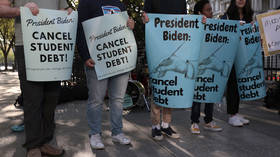Biden announces controversial student loan debt relief package

US President Joe Biden announced his long-promised student debt loan forgiveness plan on Wednesday, declaring he was honoring a campaign commitment with the package, which forgives $10,000 in student loan debt for those making under $125,000 per year and extends a pandemic-era pause on loan repayments.
However, the president’s critics on the left have argued that the plan forgives only a tiny (and relatively wealthy) portion of those Americans holding the country’s $1.7 trillion in student loan debt, while his critics on the right point out it will actually end up punishing poor Americans by driving inflation further skyward. Some even claim he doesn’t have the authority to forgive the loans at all.
Debt holders paying back a Pell Grant – the government financial subsidies given to students who can prove financial need – can have as much as $20,000 taken off their loans if they make under $75,000 per year, or $10,000 if they make under $125,000 per year. Those who make under $125,000 per year but secured loans through some other means – meaning they weren’t poor enough to qualify for a Pell Grant – can still get $10,000 slashed from their loan bill, and a pandemic-era pause on repayments has been extended until the end of the year.
Progressives pushing for loan forgiveness had demanded $50,000 or even the entirety of students’ loans be retired, noting that the average loan balance is $37,667. The loan issue is seen as vital to attracting young voters to the Democratic Party come November.
The Republican members of the House Ways and Means Committee have argued the program’s cost – between $300 billion and $980 billion over the next decade, according to the Penn-Wharton Budget Model – actually punishes poor Americans at the expense of the relatively well-off by turbo-charging inflation. Given that 87% of Americans don’t even have student loans, they get zero benefit from the package and must shoulder the inflation burden anyway.
Many of the president’s opponents have argued his cabinet lacks the legal right to cancel debts without congressional approval. The Education Department has stepped in to defend Biden, explaining in a legal memo released on Wednesday that the 2003 HEROES Act gives it power to waive or modify federal student loan rules during a declared national emergency – such as the recently-extended coronavirus pandemic. A memo explicitly stating the Secretary of Education does not have the right to cancel loans wholesale, written by a Trump-era appointee and released last January, has been officially walked back.













